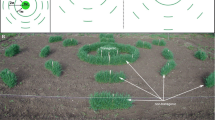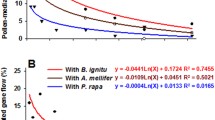Abstract
Gene flow is one of the major concerns associated with the release of transgenic plants into the environment. Unrestricted gene flow can results in super weeds, reduction in species fitness and genetic diversity, and contamination of traditional plants and foods. Thus, it is important and also necessary to evaluate the extent of gene flow in the field for transgenic plants already released or being considered for a release. Transgenic cotton is among the first transgenic crops for commercialization, which are widely cultivated around the world. In this chapter, we use transgenic insect-resistant cotton and herbicide-tolerant cotton as two examples to present a field practice method for determining transgene flow in cotton. The procedure includes three major sections: (1) field design, (2) seed collection, and (3) field and lab bioassay.
Access this chapter
Tax calculation will be finalised at checkout
Purchases are for personal use only
Similar content being viewed by others
References
Slatkin M (1985) Gene flow in nature populations. Annu Rev Ecol Syst 16:393–430
Lenormand T (2002) Gene flow and the limits to natural selection. Trends Ecol Evol 17:183–189
Chevre AM, Eber F, Baranger A, Renard M (1997) Gene flow from transgenic crops. Nature 389:924–924
Snow AA (2002) Transgenic crops—why gene flow matters. Nat Biotechnol 20:542–542
Tsatsakis AM, Nawaz MA, Kouretas D, Balias G, Savolainen K, Tutelyan VA, Golokhvast KS, Lee JD, Yang SH, Chung G (2017) Environmental impacts of genetically modified plants: a review. Environ Res 156:818–833
Showalter AM, Heuberger S, Tabashnik BE, Carriere Y (2009) A primer for using transgenic insecticidal cotton in developing countries. J Insect Sci 9:22
Vermij P (2006) Liberty Link rice raises specter of tightened regulations. Nat Biotechnol 24:1301–1302
Smyth S, Khachatourians GG, Phillips PWB (2002) Liabilities and economics of transgenic crops. Nat Biotechnol 20:537–541
Zhang BH, Feng R (2000) Cotton resistance to insect and transgenic cotton. China Agricultutal Science and Technology Press, Beijing
Zhang BH, Liu F, Yao CB, Wang KB (2000) Recent progress in cotton biotechnology and genetic engineering in China. Curr Sci 79:37–44
Heuberger S, Ellers-Kirk C, Tabashnik BE, Carriere Y (2011) Pollen- and seed-mediated transgene flow in commercial cotton seed production fields. PLoS One 5:e14128
Zhang BH, Pan XP, Guo TL, Wang QL, Anderson TA (2005) Measuring gene flow in the cultivation of transgenic cotton (Gossypium hirsutum L.). Mol Biotechnol 31:11–20
Llewellyn D, Fitt G (1996) Pollen dispersal from two field trials of transgenic cotton in the Namoi Valley, Australia. Mol Breed 2:157–166
Umbeck PF, Barton KA, Nordheim EV, McCarty JC, Parrott WL, Jenkins JN (1991) Degree of pollen dispersal by insect from a field test of genetically engineered cotton. J Econ Entomol 84:1943–1950
Wegier A, Pineyro-Nelson A, Alarcon J, Galvez-Mariscal A, Alvarez-Buylla ER, Pinero D (2011) Recent long-distance transgene flow into wild populations conforms to historical patterns of gene flow in cotton (Gossypium hirsutum) at its centre of origin. Mol Ecol 20:4182–4194
Free, J. B. (1970) Insect pollination of crops, In Insect Pollination of Crops, p 544
Permingeat HR, Romagnoli MV, Sesma JI, Vallejos RH (1998) A simple method for isolating DNA of high yield and quality from cotton (Gossypium hirsutum L.) leaves. Plant Mol Biol Report 16:89–89
Author information
Authors and Affiliations
Corresponding author
Editor information
Editors and Affiliations
Rights and permissions
Copyright information
© 2019 Springer Science+Business Media, LLC, part of Springer Nature
About this protocol
Cite this protocol
Pan, X. (2019). Determining Pollen-Mediated Gene Flow in Transgenic Cotton. In: Zhang, B. (eds) Transgenic Cotton. Methods in Molecular Biology, vol 1902. Humana Press, New York, NY. https://doi.org/10.1007/978-1-4939-8952-2_25
Download citation
DOI: https://doi.org/10.1007/978-1-4939-8952-2_25
Published:
Publisher Name: Humana Press, New York, NY
Print ISBN: 978-1-4939-8951-5
Online ISBN: 978-1-4939-8952-2
eBook Packages: Springer Protocols




